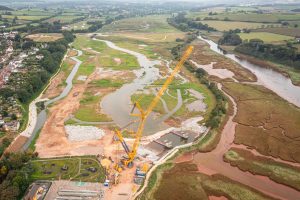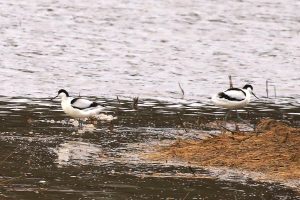2024 Award Winner’s Spotlight: Best Practice Award: Large-Scale Mitigation
Environment Agency/Clinton Devon Estates
Project Name: Lower Otter Restoration Project
This award was sponsored by:


The Flood defences around the Exe Estuary protect almost 3000 properties. Maintenance and construction of flood defences, coupled with rising sea levels, lead to the gradual loss of intertidal habitats. This loss occurs as the intertidal zone gets “squeezed” between the rising low tide mark and human-made barriers like flood defences. To address this ecological challenge, the Lower Otter Restoration Project was launched with a budget of £27 million and focusing on Budleigh Salterton. This project aimed to provide compensatory habitat for the losses experienced in the adjacent Otter Estuary and enhance community and ecosystem resilience against rising sea levels.
Led by a partnership between the Environment Agency and Clinton Devon Estates, the project collaborated closely with designers from Jacobs and contractors from Kier. The project’s design and execution followed an iterative approach, prioritising the mitigation hierarchy.![]()
Construction spanned nearly 30 months, concluding in December 2023, and involved extensive infrastructural adjustments to mitigate flood risks and restore natural hydrological processes. Notable interventions included relocating infrastructure out of floodplains, enhancing flood-resilience of existing structures, and breaching the estuary’s tidal embankment to re-establish connections between the floodplain and the sea.
While the project incurred losses of low-grade semi-improved grassland, hedgerows, and woodland, these were mitigated by creating compensatory salt marsh and mudflat habitats, fostering a more resilient ecosystem. Additional mitigations included freshwater habitat creation, rare plant species translocation, and strengthening of existing hedgerows. Ongoing monitoring ensures the effectiveness of these mitigation efforts, encompassing protected species such as dormice and beavers, as well as habitat assessments.
 The project’s unique scope, executed within an Area of Outstanding Natural Beauty (AONB) and near a populous town, underscores its significance. Stakeholder engagement was pivotal, ensuring diverse perspectives were considered in design decisions, thus minimising impacts on site biodiversity. Moreover, the project serves as a blueprint for climate change adaptation, demonstrating innovative approaches to reducing carbon footprint and enhancing ecosystem resilience.
The project’s unique scope, executed within an Area of Outstanding Natural Beauty (AONB) and near a populous town, underscores its significance. Stakeholder engagement was pivotal, ensuring diverse perspectives were considered in design decisions, thus minimising impacts on site biodiversity. Moreover, the project serves as a blueprint for climate change adaptation, demonstrating innovative approaches to reducing carbon footprint and enhancing ecosystem resilience.
Beyond compensatory habitat creation, the project prioritised river restoration, opening up Budleigh Brook for eel and fish passage, thereby revitalising freshwater ecosystems. Landscape enhancements, such as removing overhead power cables and creating footpaths and bird viewing areas, improve public access and appreciation of the site. The project’s commitment to environmental stewardship is evident in its extensive broadleaf woodland expansion, hedgerow planting, and landfill remediation efforts.
By employing low-carbon construction materials and engaging local suppliers, the project exemplifies resource efficiency and community involvement. Its socio-economic benefits, including enhanced recreational opportunities, improved physical health, water quality, and carbon sequestration, underscore its holistic approach to environmental management.
In conclusion, the Lower Otter Restoration Project stands as a testament to the efficacy of large-scale habitat restoration in mitigating the adverse impacts of flood defences while bolstering ecosystem resilience and providing socio-economic benefits to local communities. Through meticulous planning, stakeholder engagement, and innovative mitigation strategies, the project sets a precedent for excellence in sustainable coastal management and climate change adaptation initiatives.